Project-Based Curriculum for Teaching Analytical Design to Freshman Engineering Students via Reconfigurable Trebuchets
Abstract
:1. Introduction
1.1. Project-Based Learning via Trebuchets
1.2. Previous Pedagogical Use of Trebuchets
1.3. Transition from Seminar-Based Course
1.4. Curriculum Overview
- Rank the design variables from 1 to 4 in order of importance;
- Identify variable ranges (min and max) that you would like to test using the physical trebuchet kit for guidance;
- Plan for a budget of eight total experiments with suggestions for space-filling experiments.
- Perform three predefined tests and report the distance;
- Answer the following question: “What is a good finger angle when sling length is 26 in and the pivot location is 4 in? Why?” (which is a single variable optimization problem);
- Rank the design variables from 1 to 4 in order of importance (repeat from the DOE activity);
- Plan for a budget of six total experiments for field day #2;
- (optional) Test more designs at home.
- Review of both quantitative and qualitative results from all of the project activities, including analysis of experimental results;
- Comparison of variable rankings based on student intuition (before and after the modeling lab);
- Discussion on the effectiveness of the launch day movement policies and comparison with multi-agent modeling results;
- Exploration of a comprehensive data set based on the trebuchet model to more fully understand the trebuchet design problem and the complex tradeoffs involved;
- Discussion on the explicit reasons for why engineering students take math and engineering analysis courses and how these topics are directly useful in engineering practice;
- Asking students their definitions of engineering intuition and judgment, and how course activities influenced their understanding of these ideas;
- Discussion on the value and potential problems with using modeling and simulation in engineering practice;
- Engaging students in a discussion on what they learned about developing a systems perspective for engineering design;
- Review of a variety of strategies for engineering design, including their different levels of analytical rigor, as well as the role of human creativity across all design strategies.
1.5. Learning Objectives
2. Reconfigurable Trebuchet Kits
- Reproducibility across trebuchet kits for fair comparisons and use with a computer model;
- Reconfigurable capability to support rapid student adjustment of design variables (under 5 min);
- Streamlined assembly process, enabling most student groups to complete assembly process in less than 40 min given written instructions, components, fasteners, and tools;
- Portability (two college-level students can transport them small distances);
- Durability (multiple years of use, rain/weather protection);
- Reasonable cost (approximately $150 per kit, including all materials, hardware, tools, and manufacturing tools).
3. Interactive Computational Models
3.1. Design for Maximum Range through Physics-Based Modeling
3.2. Process Model for Field Day Logistics
- Assigned stations — Each team is assigned a station and they rotate with other teams assigned to the same station;
- Random stations — Teams join a random queue without any thought;
- Shortest queue — When teams are ready, they join a station with the shortest line.
4. Student Improvements in Trebuchet Comprehension and Engineering Judgment
4.1. Setup
4.1.1. Participants
4.1.2. Instruments and Design—Four Course Activities
4.2. Results and Discussion
4.2.1. Design Variable Rankings
4.2.2. Statistical Analysis of Field Day Launch Distances
- : field day #1 launch distance (before model-based design activity);
- : field day #2 launch distance (after model-based design activity and field day #1);
- ; There is no difference between mean launch distances of day 1 and day 2;
- ; There is a difference between mean launch distances of day 1 and day 2.
4.2.3. Qualitative Assessment of Student Reflections on Mathematical and Scientific Tools in Engineering Practice
How do mathematical and scientific tools, such as mathematical modeling and simulation, play an important role in engineering practice?
4.2.4. Students vs. Optimization Algorithm
5. Conclusions
Supplementary Materials
- SimMechanicsTM model described in Section 3.1;
- AnyLogic® model described in Section 3.2;
- Manufacturing instructions;
- Assembly instructions;
- Launch day instructions given to the students to help them understand the logistics and safety of the launch day;
- DOE activity assignment;
- Model-based design activity assignment;
- CAD files of the various trebuchet parts;
- Short video of the events.
Acknowledgments
Author Contributions
Conflicts of Interest
References
- What is Project Based Learning (PBL)? Available online: http://bie.org/about/what_pbl (accessed on 20 February 2016).
- Solomon, G. Project Based Learning: The Primer. Tech Learn. Mag. 2003, 23, 20–26. [Google Scholar]
- Pilot, A.; Bulte, A.M.W. The use of “contexts” as a challenge for the chemistry curriculum: Its successes & the need for further development and understanding. Int. J. Sci. Educ. 2006, 28, 1084–1112. [Google Scholar]
- Mills, J.E.; Freagust, D. Engineering education—Is problem-based or project-based learning the answer? Australas. J. Eng. Educ. 2003, 3, 1–16. [Google Scholar]
- National Science Foundation. Systemic Engineering Education Reform: An Action Agenda; Technical Report; National Science Foundation: Arlington, VA, USA, 1997. [Google Scholar]
- Tempelman, E.; Pilot, A. Strengthening the link between theory and practice in teaching design engineering: An empirical study on a new approach. Int. J. Technol. Des. Educ. 2011, 21, 261–275. [Google Scholar] [CrossRef]
- Savage, R.N.; Chen, K.C.; Vanasupa, L. Integrating project-based learning throughout the undergraduate engineering curriculum. J. STEM Educ. 2007, 8, 15–27. [Google Scholar] [CrossRef]
- Dym, C.L.; Agogino, A.M.; Eris, O.; Frey, D.D.; Leifer, L.J. Engineering design thinking, teaching, and learning. J. Eng. Educ. 2005, 94, 103–120. [Google Scholar] [CrossRef]
- Hadim, H.A.; Esche, S.K. Enhancing the engineering curriculum through project-based learning. In Proceedings of the 32nd Annual Frontiers in Education, Boston, MA, USA, 6–9 November 2002; Volume 2.
- Silk, E.M.; Schunn, C.D.; Cary, M.S. The impact of an engineering design curriculum on science reasoning in an urban setting. J. Sci. Educ. Technol. 2009, 18, 209–223. [Google Scholar] [CrossRef]
- Wallace, K. (Ed.) Educating Engineers in Design; Royal Academy of Engineering: London, UK, 2005.
- Frost, R.B. A converging model of the design process: Analysis and creativity, the ingredients of synthesis. J. Eng. Des. 1992, 3, 117–126. [Google Scholar] [CrossRef]
- Daly, S.R.; Yilmaz, S.; Christian, J.L.; Seifert, C.M.; Gonzalez, R. Design heuristics in engineering concept generation. J. Eng. Educ. 2012, 101, 601–629. [Google Scholar] [CrossRef]
- Carberry, A.R.; McKenna, A.F. Exploring student conceptions of modeling and modeling uses in engineering design. J. Eng. Educ. 2014, 103, 77–91. [Google Scholar] [CrossRef]
- Basili, V.R.; Shull, F.; Lanubile, F. Building knowledge through families of experiments. IEEE Trans. Softw. Eng. 1999, 25, 456–473. [Google Scholar] [CrossRef]
- Evans, J.R. Engineering Design: Search and Evaluation; Coherence and Correspondence; Intuition and Analysis. M.S. Thesis, Massachusetts Institute of Technology, Cambridge, MA, USA, 2009. [Google Scholar]
- Papalambros, P.Y.; Wilde, D.J. Principles of Optimal Design: Modeling and Computation; Cambridge University Press: Cambridge, UK, 2000. [Google Scholar]
- Brice, L.L.; Catania, S. A pedagogical trebuchet: A case study in experimental history and history pedagogy. Hist. Teach. 2012, 46, 67–84. [Google Scholar]
- Leifer, J. An Active Learning Design Project for a Junior-level Kinematics and Dynamics Class. In Proceedings of the 32nd Annual Frontiers in Education, Boston, MA, USA, 6–9 November 2002; Volume 1.
- Jahed, H. Trebuchet Design; ME380 Project Manual; University of Waterloo: Waterloo, ON, Canada, 2006. [Google Scholar]
- Brannan, K.P.; Murden, J.A.; Stout, R.H., Jr. The Great Trebuchet Project. In Proceedings of the 2002 ASEE Southeast Section Conference, Gainesville, FL, USA, 7–9 April 2002.
- Leonard, K.M.; Mastromonico, J.J., Jr. Integrating Engineering Design Heuristics into a First Year Engineering Course to Enhance Problem Solving and Team Building Skills. In Proceedings of the 2007 International Conference on Engineering Education, Coimbra, Portugal, 3–7 September 2007.
- Kenefic, R.; Lin, F.; Aschliman, D. Integrated design and analysis for a trebuchet using a high speed photographic measurement system and MATLAB. In Proceedings of the 2006 ASEE Illinois-Indiana and North Central Joint Section Conference, Fort Wayne, IN, USA, 31 March–1 April 2006.
- Slater, J. Making math and science exciting through engineering sport: The wright state university trebuchet competition. In Proceedings of the 2008 ASEE Annual Conference and Exposition, Pittsburgh, PA, USA, 22–25 June 2008. Number AC 2008-2221.
- Constans, E.; Constans, A. Treb-bot: Development and use of a trebuchet simulator. Phys. Teach. 2015, 53, 347–348. [Google Scholar] [CrossRef]
- English, L.D.; Hudson, P.; Dawes, L. Engineering-based problem solving in the middle school: Design and construction with simple machines. J. Pre-Coll. Eng. Educ. Res. 2013, 3. [Google Scholar] [CrossRef] [Green Version]
- Allison, J. Trebuchet Range Simulation and Optimization; MATLAB Central: Natick, MA, USA, 2012. [Google Scholar]
- Forrester, A.; Sobester, A.; Keane, A. Engineering Design via Surrogate Modelling: A Practical Guide; Wiley: Hoboken, NJ, USA, 2008. [Google Scholar]
- Bonabeau, E. Agent-based modeling: Methods and techniques for simulating human systems. Proc. Natl. Acad. Sci. USA 2002, 99, 7280–7287. [Google Scholar] [CrossRef] [PubMed]
- Fishman, G. Discrete-Event Simulation: Modeling, Programming, and Analysis, 1st ed.; Springer Science & Business Media: Berlin, Germany, 2013. [Google Scholar]
- Thomas, E.W.; Marr, J.; Walker, N. Enhancement of Intuitive Reasoning through Precision Teaching and Simulations. In Proceedings of the Frontiers in Education Conference, Atlanta, GA, USA, 1–4 November 1995; Volume 2.
- Siano, D.B. Trebuchet Mechanics. Available online: http://www.algobeautytreb.com/trebmath356.pdf (accessed on 20 February 2016).
- Goebel, R.; Sanfelice, R.G.; Teel, A. Hybrid Dynamical Systems. IEEE Control Syst. 2009, 29, 28–93. [Google Scholar] [CrossRef]
- Breslow, L. Methods of Measuring Learning Outcomes and Value Added; Online Report; Teaching and Learning Laboratory: Cambridge, MA, USA, 2007. [Google Scholar]
- fmincon: version R2014a; The MathWorks, Inc.: Natick, MA, USA. Available online: http://www.mathworks.com/help/optim/ug/fmincon.html (accessed on 20 February 2016).
- patternsearch: version R2014a; The MathWorks, Inc.: Natick, MA, USA. Available online: http://www.mathworks.com/help/gads/patternsearch.html (accessed on 20 February 2016).
- Mathison, S. Why Triangulate? Educ. Res. 1988, 17, 13–17. [Google Scholar] [CrossRef]

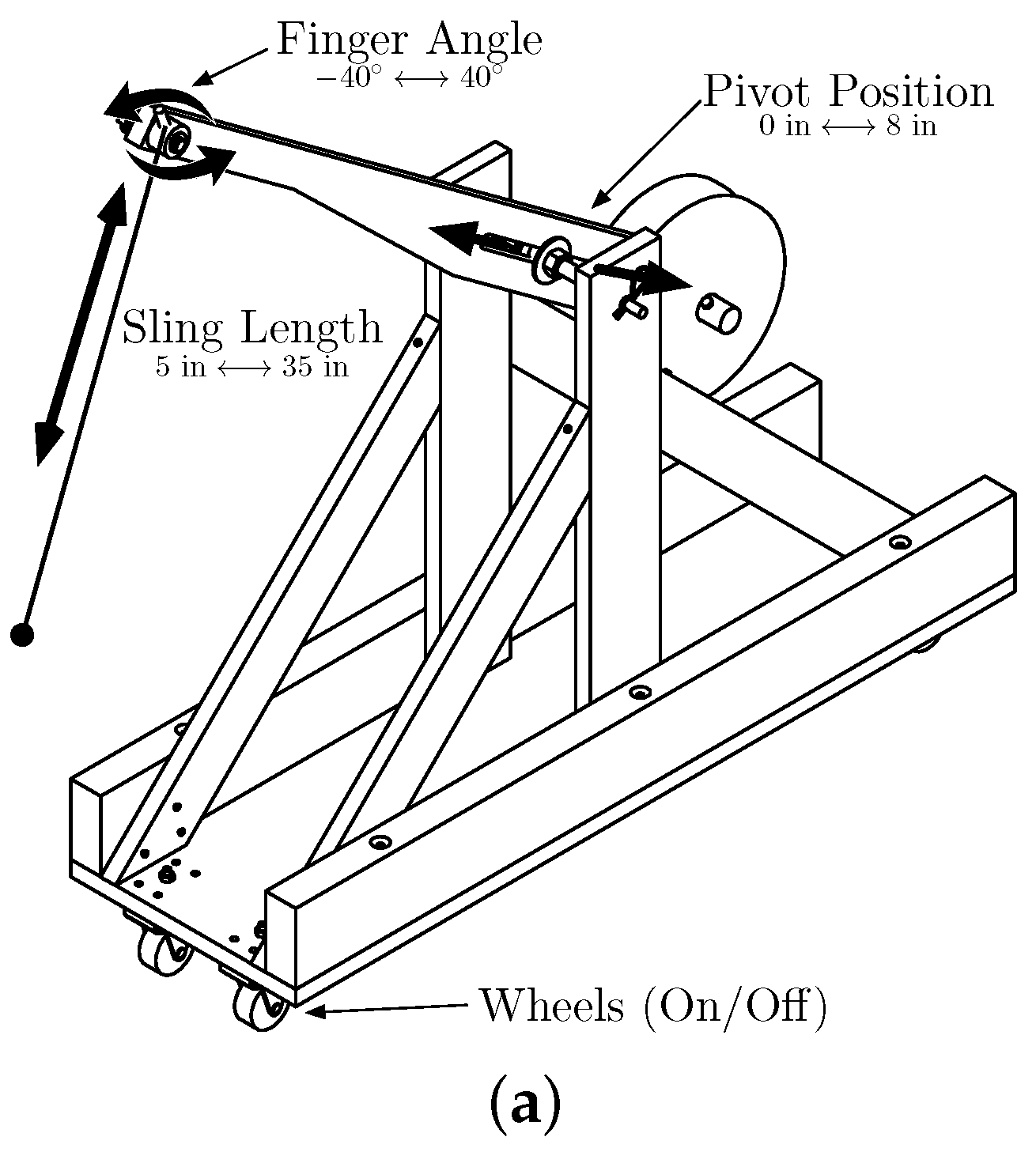
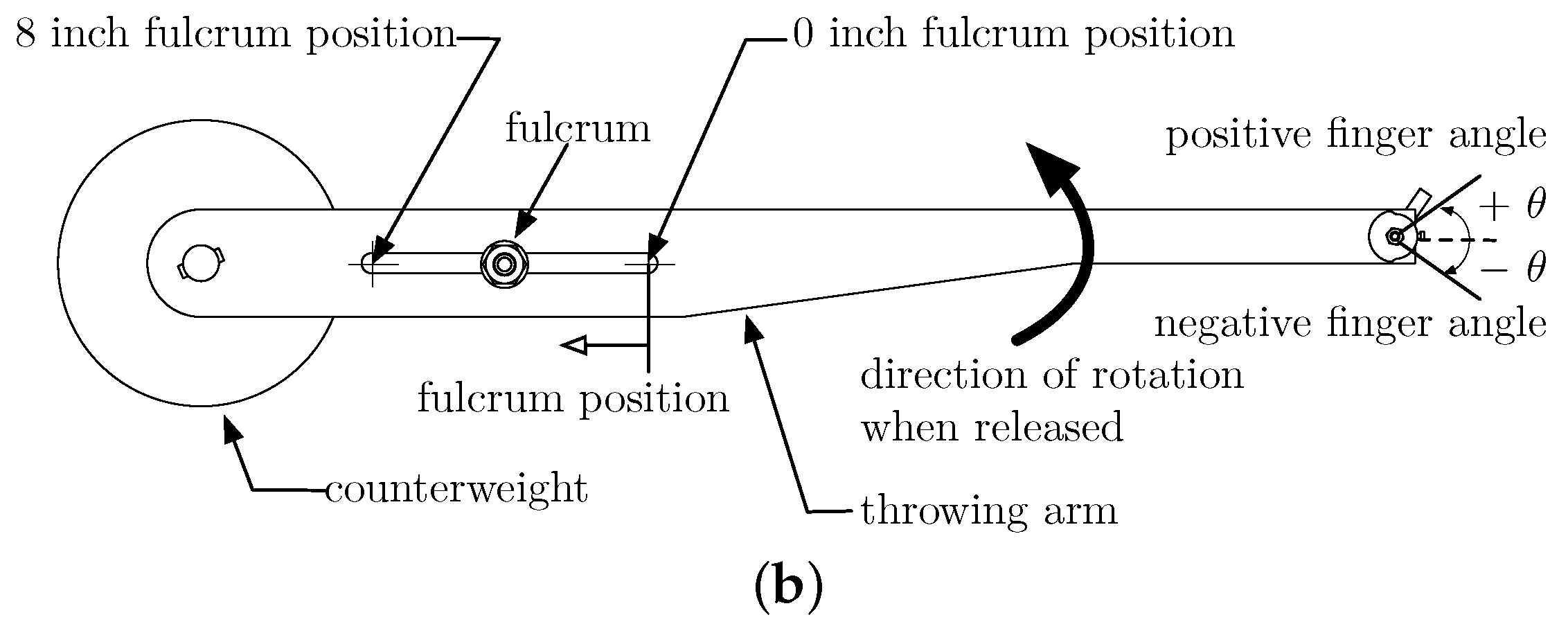
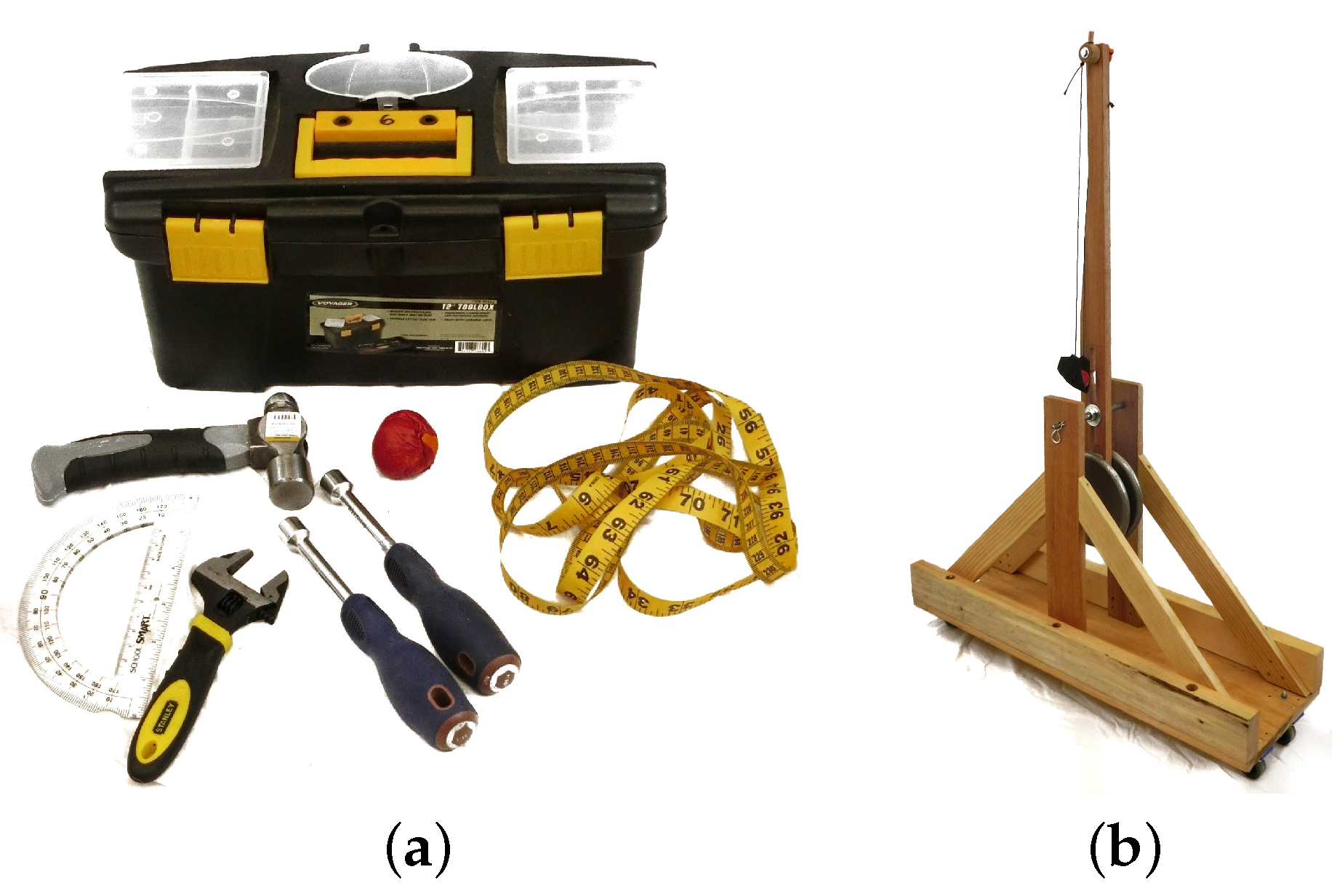
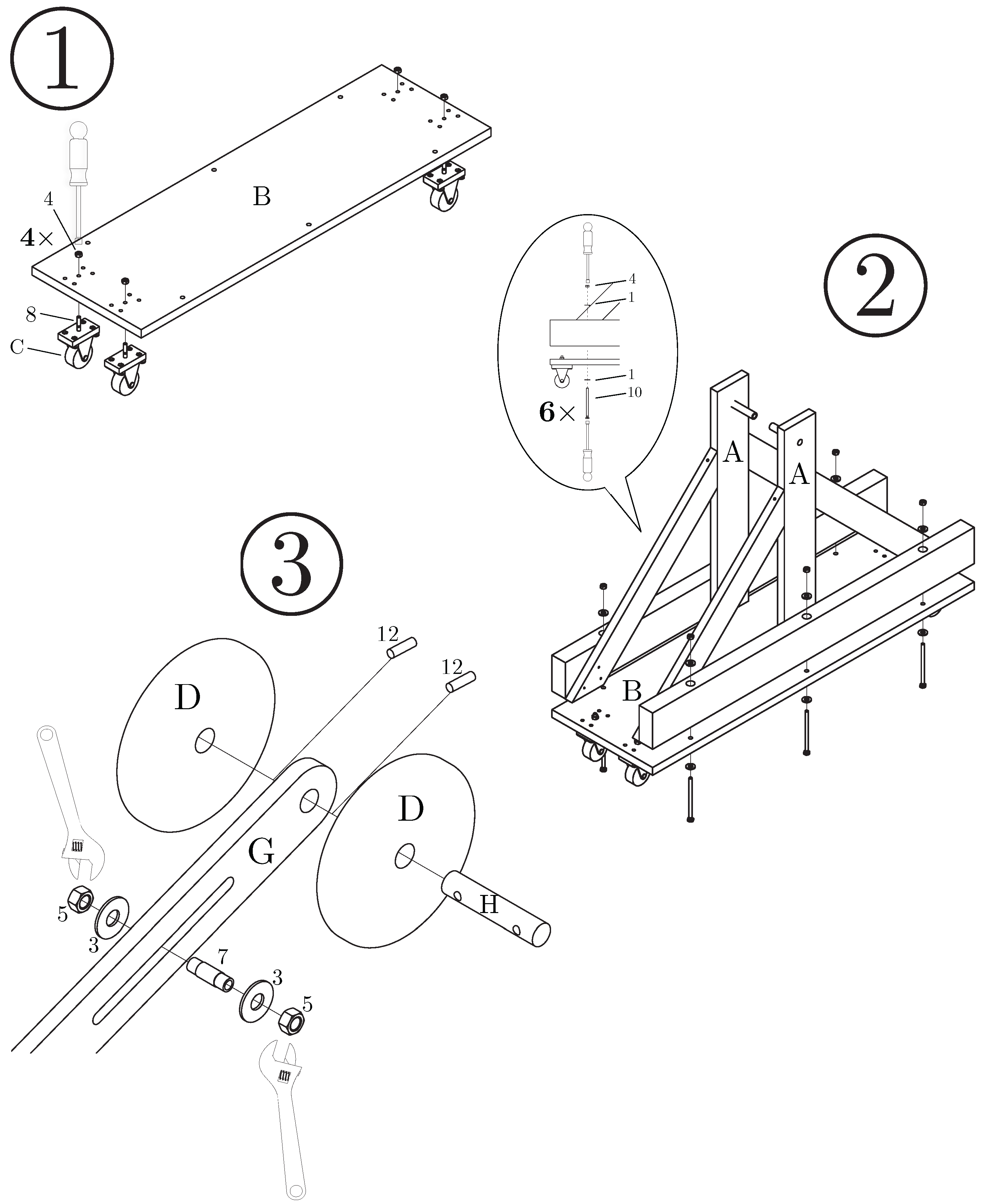


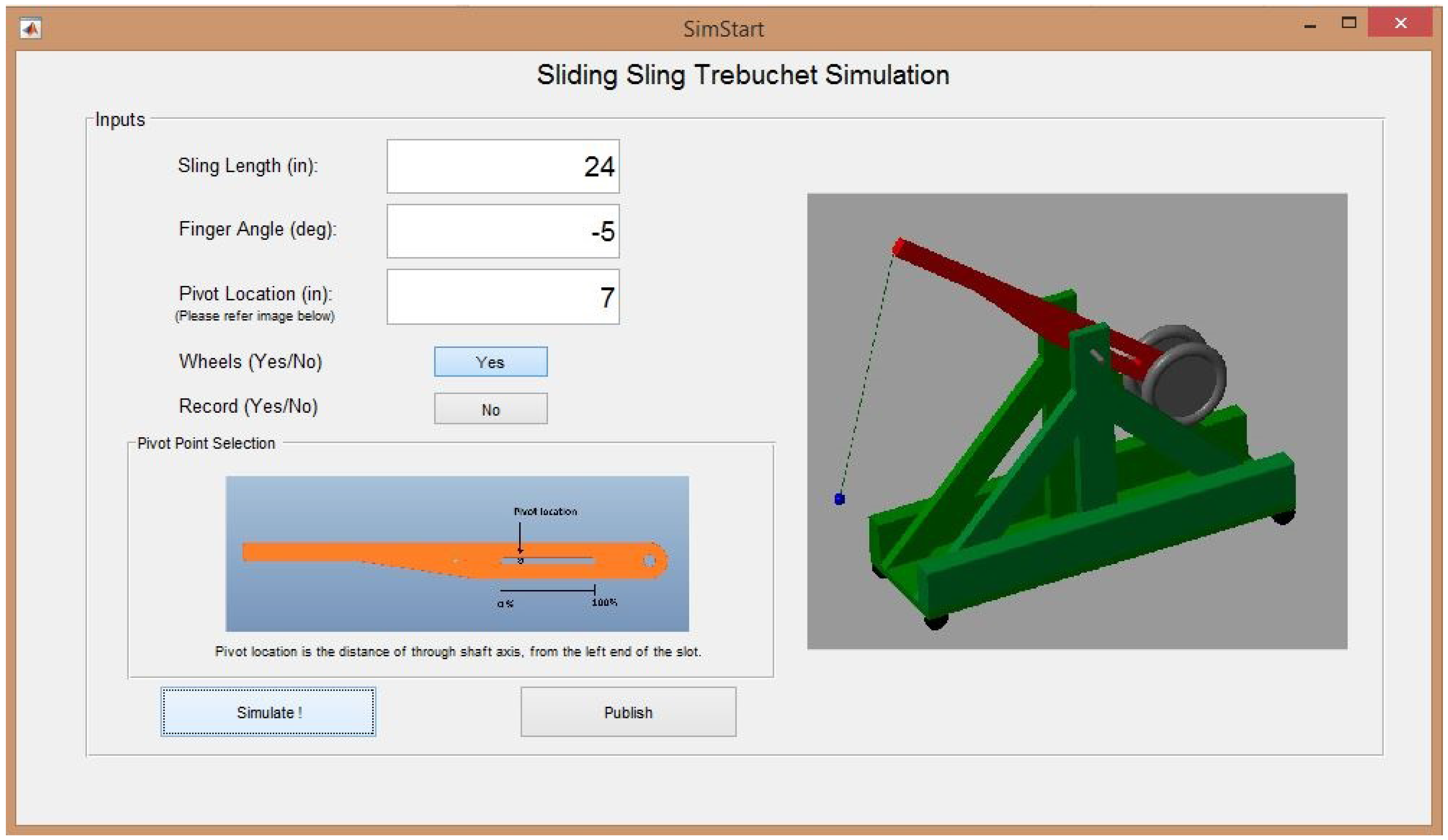


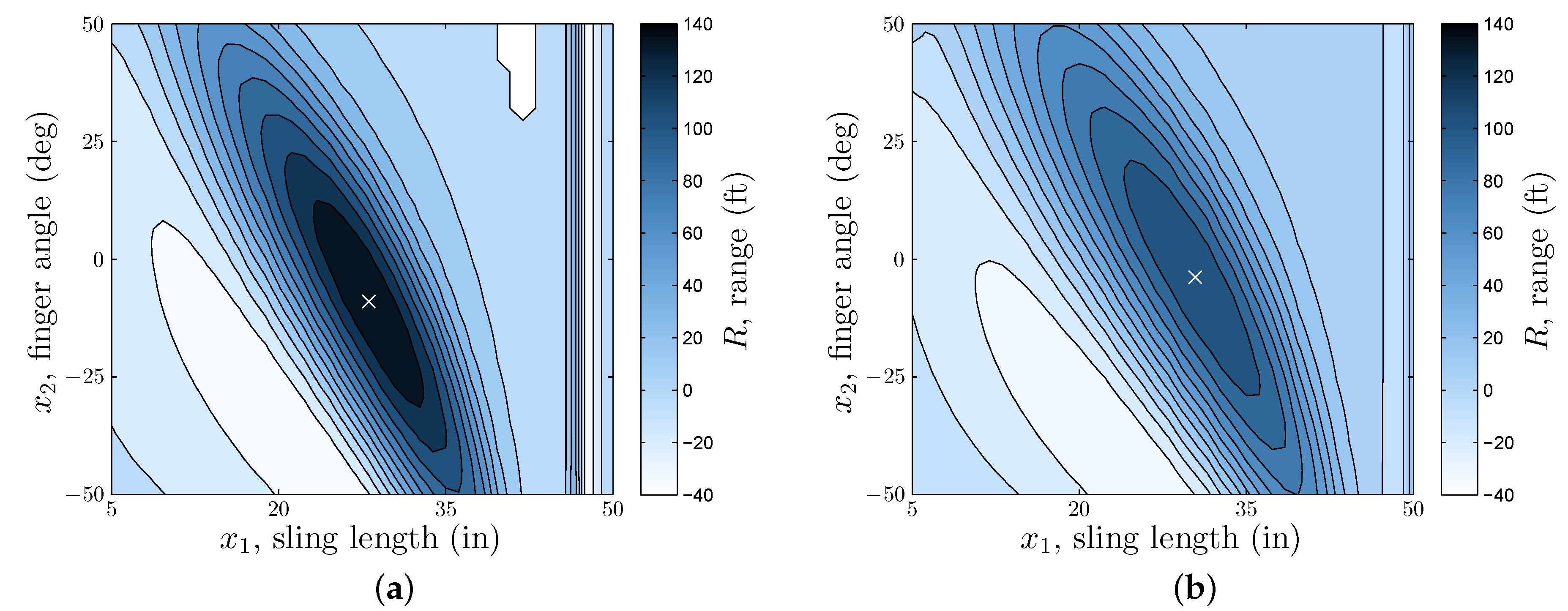
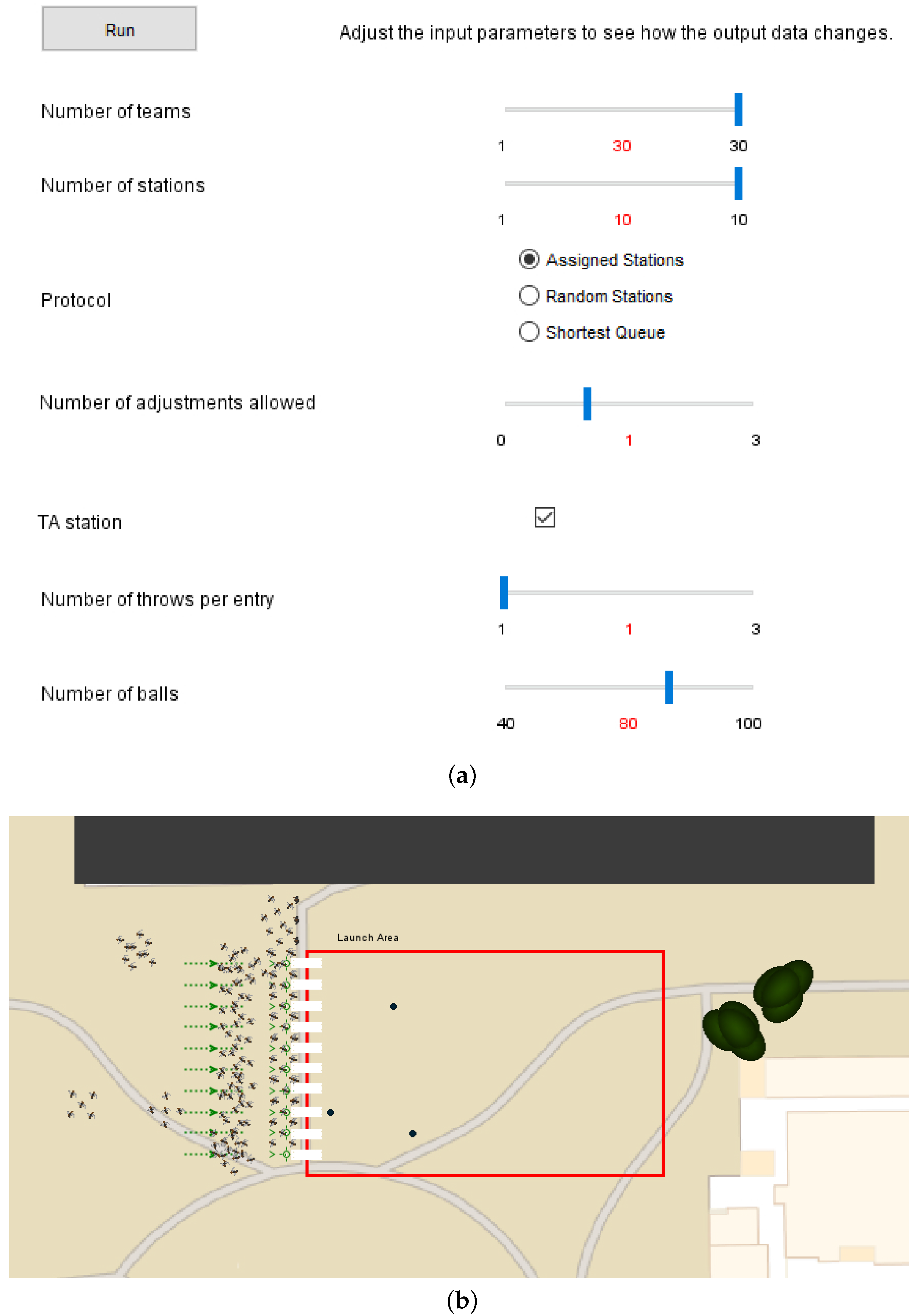
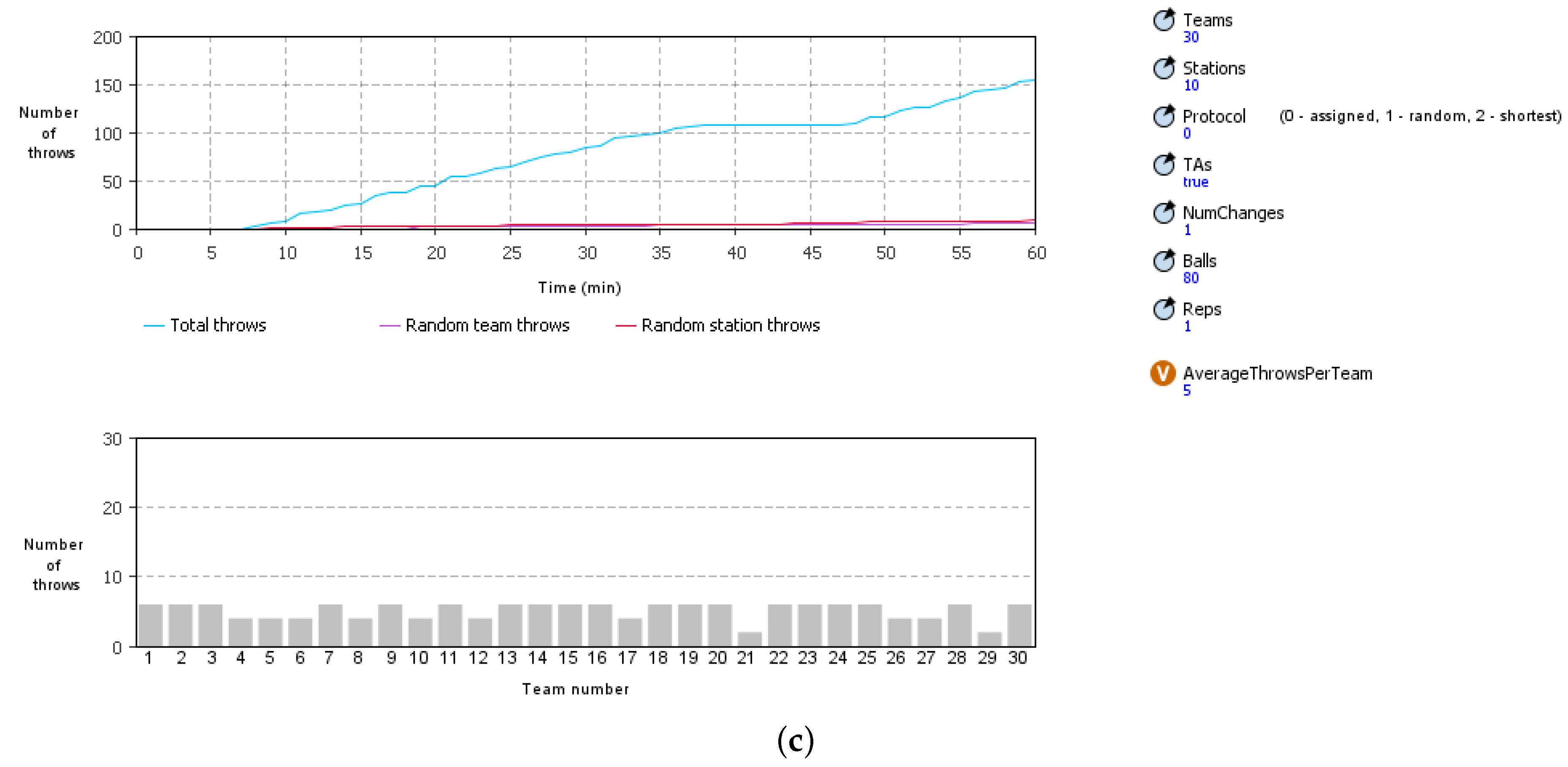

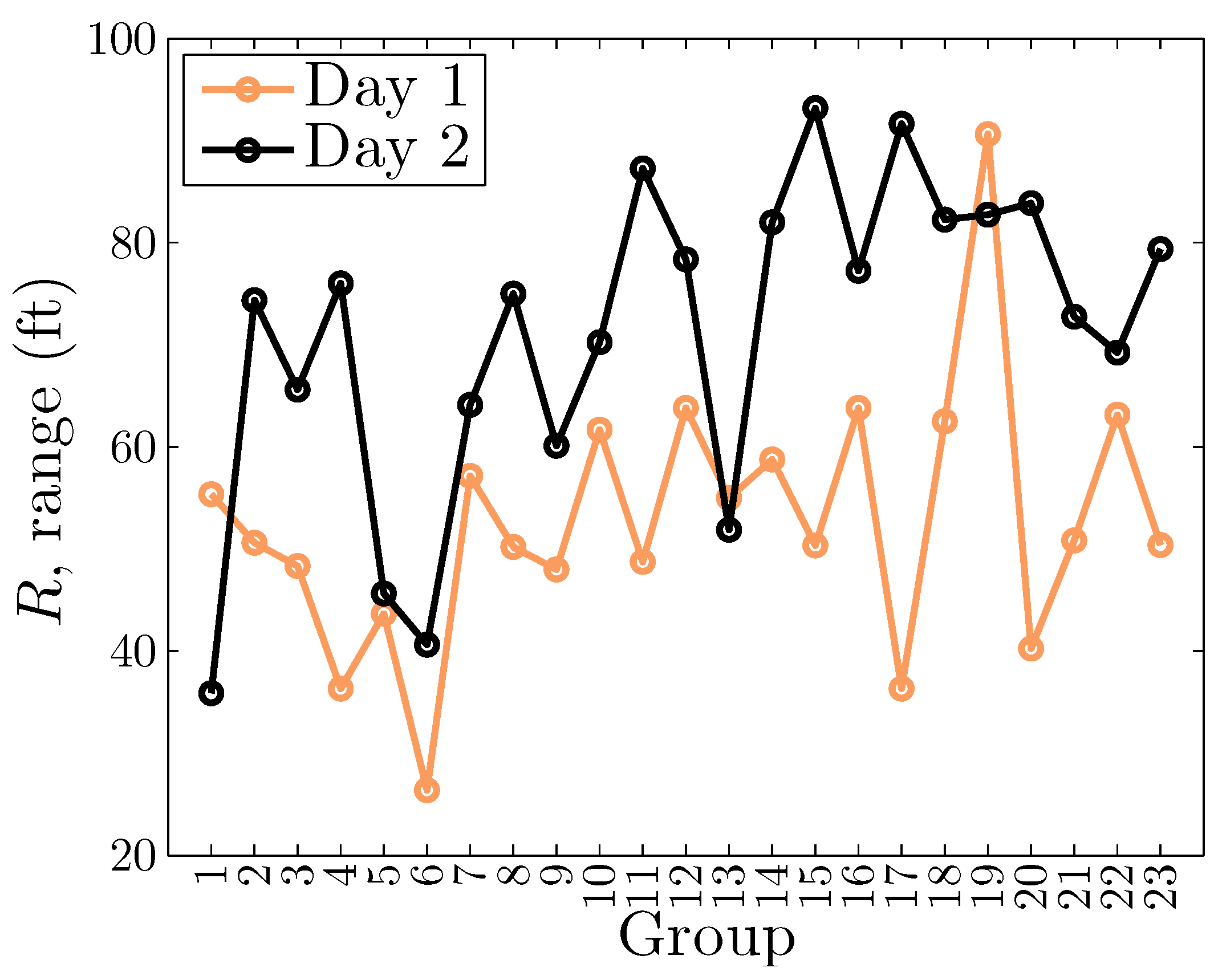
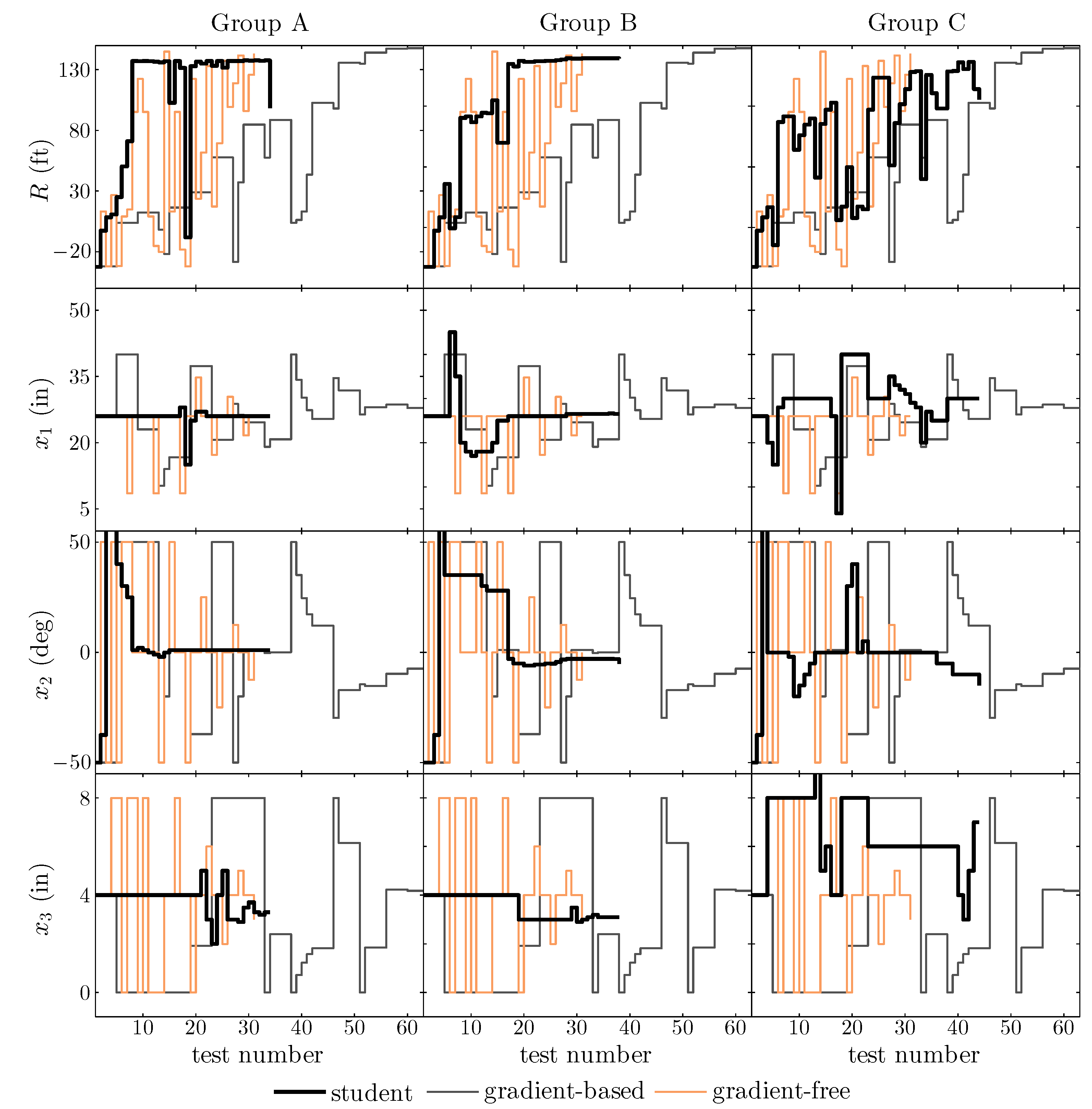
| Meeting | Week | Type | Name |
|---|---|---|---|
| 1 | 1 | Hands-on | Trebuchet Assembly |
| 2 | 2 | Hands-on | Trebuchet Assembly and DOE Activity |
| 3 | 4 | Lecture | Process Design Overview |
| 4 | 6 | Hands-on | Field Day #1 |
| 5 | 7 | Lecture | Trebuchet Physics Overview |
| 6 | 7 | Hands-on | Model-based Design Activity |
| 7 | 8 | Hands-on | Field Day #2 |
| 8 | 11 | Lecture | Project Analysis and Reflection |
| Name | Type | LB | UB | |
|---|---|---|---|---|
| Sling Length | Continuous | 5 in | 35 in | |
| Finger Angle | Continuous | −40° | 40° | |
| Pivot Position | Continuous | 0 in | 8 in | |
| Wheels | Discrete | On | Off |
| Variable | DOE Activity | MBD Activity | Instructor |
|---|---|---|---|
| Sling Length | 2.3 | 2.2 | 1 |
| Finger Angle | 2.0 | 1.8 | 2 |
| Pivot Position | 1.8 | 3.4 | 4 |
| Wheels | 3.9 | 2.5 | 3 |
| Quantity | σ | 95% CI | T | |||
|---|---|---|---|---|---|---|
| ΔRange (day 1 - day 2) | 15.652 | 38.745 | 3.298 | (9.130, 22.174) | 4.746 | 137 |
| Source | Type III Sum Sq. | Mean Square | F | p | |
|---|---|---|---|---|---|
| Corrected Model | 90972 | 45 | 2022 | 3.2 | 0 |
| Intercept | 1152161 | 1 | 1152161 | 1827.0 | 0 |
| Group | 40067 | 22 | 1821 | 2.9 | 0 |
| Day | 25845 | 1 | 25845 | 41.0 | 0 |
| Group × Day | 23328 | 22 | 1060 | 1.7 | 0.031 |
| Error | 171530 | 272 | 631 | ||
| Total | 1537276 | 318 | |||
| Corrected Total | 262503 | 317 |
© 2016 by the authors; licensee MDPI, Basel, Switzerland. This article is an open access article distributed under the terms and conditions of the Creative Commons by Attribution (CC-BY) license ( http://creativecommons.org/licenses/by/4.0/).
Share and Cite
Herber, D.R.; Deshmukh, A.P.; Mitchell, M.E.; Allison, J.T. Project-Based Curriculum for Teaching Analytical Design to Freshman Engineering Students via Reconfigurable Trebuchets. Educ. Sci. 2016, 6, 7. https://doi.org/10.3390/educsci6010007
Herber DR, Deshmukh AP, Mitchell ME, Allison JT. Project-Based Curriculum for Teaching Analytical Design to Freshman Engineering Students via Reconfigurable Trebuchets. Education Sciences. 2016; 6(1):7. https://doi.org/10.3390/educsci6010007
Chicago/Turabian StyleHerber, Daniel R., Anand P. Deshmukh, Marlon E. Mitchell, and James T. Allison. 2016. "Project-Based Curriculum for Teaching Analytical Design to Freshman Engineering Students via Reconfigurable Trebuchets" Education Sciences 6, no. 1: 7. https://doi.org/10.3390/educsci6010007






